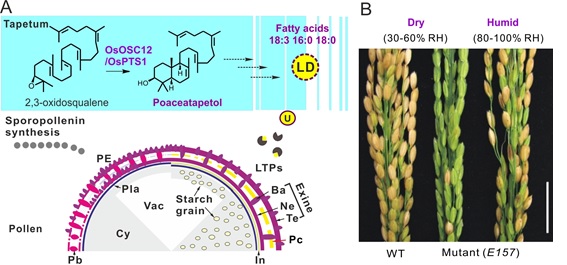
In flowering plants, pollen coat, the outermost layer of pollen grains, protects the released pollen grain from desiccation, damage and pathogen attack. The mutants that are deficient in genes restricted in pollen coat formation generally are conditional male sterile. Studies on pollen coat forming will find new male-sterile materials for hybrid breeding in crops.
A research group led by Prof. QI Xiaoquan from Institute of Botany, Chinese Academy of Sciences, has worked on terpeniods biosynthesis since 2006, and has characterized several diterpene and triterpene pathways in plants (New Phytol 193:1022, Mol Plant 6: 1726, Plant Physiol 169: 1607).
Recently, this group revealed that rice OsOSC12 catalyses the cyclization of 2, 3-oxidosqualene into a bicylic triterpene, named poaceatapetol.
Deficiency of OsOSC12/OsPTS1 leads to failure of pollen coat formation, resulting in rapid dehydration of pollen grains. The mutant plants are male sterility at low relative humidity (RH < 60%), and are fully male fertile at high RH (> 80%).
This is a new type of humidity conditional male sterility. Palmitic acid (16:0) and linolenic acid (18:3) were decreased, and stearic acid (18:0) was not detected in the mutant E157 pollen coat. Mixtures of linolenic acid and palmitic acid or stearic acid are essential and sufficient to prevent mutant pollen grains to over-dehydration.
OsOS12/OsPTS1 appears to be specific to grass species, and homologs are identified in other important cereal crops. Relevant transcripts, poaceatapetol synthase, and poaceatapetol, were all detected in the anthers of barley, maize and wheat. The conserved nature of PTS1 in grass species offers the prospect of creating a novel type of HGMS in other important crops such as wheat, barley and maize.
OsOSC12 commits a new triterpene pathway producing poaceatapetol and its esters. The three fatty acids, palmitic acid, linolenic acid and stearic acid, in the pollen coat prevent pollen over dehydration.
This result provides basis for further studies on how does the triterpene synthesis regulate the accumulation of fatty acids in the pollen coat.
The identified humidity-sensitive genic male sterility (HGMS) is another new type of conditional male sterility after the discovery of rice photoperiod-/temperature sensitive genic male sterility (P/TGMS), providing another new desirable trait for hybrid breeding in rice.
For P/TGMS, the strict requirement of temperature and photoperiod largely limits its usage in two-line hybrid rice production and cultivation.
In contrast, HGMS is not influenced by temperature and photoperiod, and can be used in hybrid rice breeding and production in areas where the RH is below 60%.
This study entitled "Deficiency of a triterpene pathway results in humidity-sensitive genic male sterility in rice" has been published online in Nature Communications.
This work was supported by funds from the National Natural Science Foundation of China and the Key Project of Chinese National Programs for Fundamental Research and Development (973).

A triterpene pathway regulating formation of pollen coat and humidity-sensitive genic male sterility in rice (Image by QI Xiaoquan)

86-10-68597521 (day)
86-10-68597289 (night)

86-10-68511095 (day)
86-10-68512458 (night)

cas_en@cas.cn

52 Sanlihe Rd., Xicheng District,
Beijing, China (100864)

